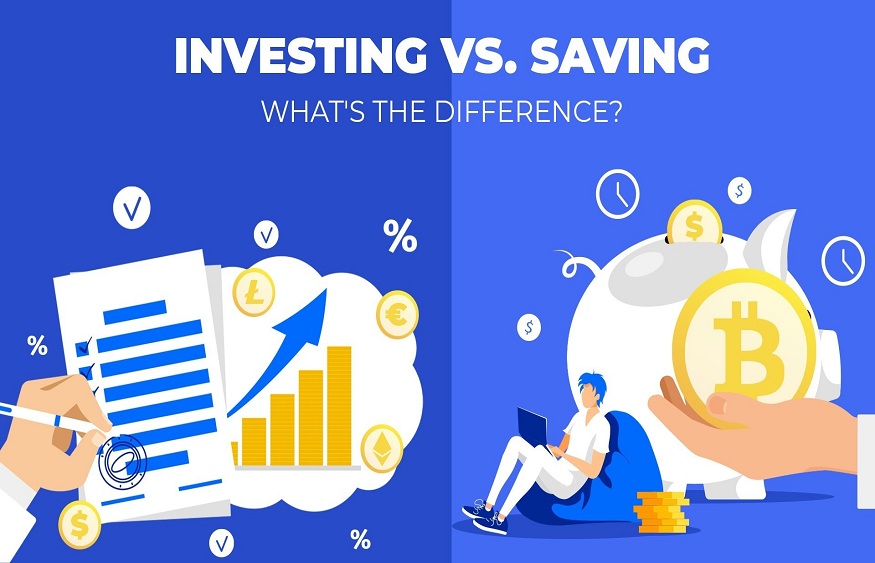In personal finance, saving and investing are frequently used interchangeably. However, it is essential to note that these accounts encompass two distinct approaches to wealth accumulation, each offering advantages and considerations. Saving involves setting aside some of your income and keeping it in a safe and easily accessible account, providing a financial safety net and the ability to cover unexpected expenses.

On the other hand, investing entails allocating funds to various assets to generate returns over time. I can include stocks, bonds, real estate, or even starting a business. While saving provides stability and liquidity, investing has the potential for higher long-term growth but carries a certain degree of risk.
By understanding the differences between these two financial strategies, you can make informed financial and trading decisions that support your goals and risk tolerance, ultimately paving the way to a more secure and prosperous future.
Saving: safety and accessibility
Saving refers to periodically setting aside a portion of one’s income, typically in a low-risk financial instrument like a savings account or a certificate of deposit (CD). The core objective of saving is to preserve capital and maintain liquidity. Money saved is easily retrievable in an emergency or a large purchase.
Most banks offer a saving plan or savings account and CDs with competitive interest rates, providing investors a modest return on their capital over time. The downside is that these returns are usually far lower than those achieved through more aggressive strategies such as stocks and real estate investment.
Investing: growth and risk
Investing involves using your capital to purchase various assets to generate positive returns. It can involve purchasing stocks, bonds, mutual funds, real estate properties or starting a business. The primary benefit of investing is the potential for significant growth over time as markets rise and asset values appreciate.
It should be noted that investments also carry a certain degree of risk. Markets are subject to volatility, meaning prices can fluctuate significantly over short periods. As such, investments should be made with the understanding that there is no guarantee of returns and that capital may be lost in some cases.
Finding the right balance
Saving and investing in Singapore is essential to a successful financial strategy. When allocating funds, it is essential to strike a balance between the two. Saving provides stability and liquidity, while investing has the potential for higher returns over time.
By understanding these differences and creating a plan that fits your needs, you can develop strategies tailored to your financial goals. It may include setting aside a certain percentage of income for savings while allocating the rest to investments. With the right approach, you can ensure a secure and prosperous future.
Reviewing your portfolio regularly is essential to adjust for any market or life changes. By monitoring your financial progress over time, you can make better financial decisions that best serve your financial interests and allow you to reach your long-term objectives.
The power of savings and investments
Savings and investments represent the foundation of any sound financial strategy. Understanding these two approaches allows you to make decisions that best serve your interests and propel you towards lasting wealth. With the right combination of safety and growth, savings and investing can provide stability in an uncertain world – and put you on track for a secure and prosperous future.
How to save and invest in Singapore
For traders who want to embark on the journey of saving and investing in Singapore, it is crucial to comprehend your financial objectives, risk tolerance, and the array of investment options available. Singapore’s thriving financial sector presents its residents with many opportunities for saving and investing.
The most common option for saving is to open a savings account in a bank like DBS, OCBC, or UOB. These banks offer different types of accounts with varying interest rates to suit your needs. Additionally, consider setting up a fixed deposit or participating in the Singapore Savings Bonds (SSB) scheme for a safe and predictable return.
As for investing, the Singapore Exchange (SGX) provides various investment options, including buying stocks, Exchange Traded Funds (ETFs), and bonds. It would help to consider investing in Real Estate Investment Trusts (REITs) for exposure to the property market or mutual funds for a diversified investment portfolio.
Getting started may seem intimidating, but it is crucial to take the first step. Even small savings and investments can compound over time, accumulating significant wealth. Remember, it’s about making money and ensuring financial security for yourself and your loved ones.
With that said
Savings and investing are two distinct approaches to wealth accumulation, each offering advantages and considerations. By understanding the differences between these financial strategies, you can create the perfect plan that fits your needs and puts you on track for long-term success. With the right approach, saving and investing can propel you towards a secure and prosperous future.
From time-tested strategies like savings accounts and CDs to higher-risk investments, understanding the options available can help you make informed decisions about utilising your capital. With careful planning and regular portfolio review, you can pursue financial freedom and position yourself for success in any market or life circumstance.


